A Tryst With The White-Winged Wood Duck
First published in Sanctuary Asia,
Vol. 43
No. 12,
December 2023
By Dr. Anwaruddin Choudhury
I had just entered the Kasijan area of Dum Duma Reserve Forest in far eastern Assam, when I heard a honk from the top of a hollong tree – a tall dipterocarp, the state tree of Assam. Soneswar Kalita, a member of the forest staff, called out – “Sir, look – a Wood Duck!” It was December 10, 1992, and my first encounter with a species that I later helped to get notified as the state bird of Assam. That day was also the beginning of my 30-year (and ongoing) tryst with this extremely endangered bird. We continued our trek south, where we stumbled upon three more White-winged Wood Ducks Asarcornis scutulata – a male and two females, honking continuously as they flew past; an unforgettable sight! I was posted in Tinsukia as a Project Director of Rural Development then and had already spent considerable time in the dense forests in this corner of the country, and this speckled duck intrigued me as it was among the rarest in the world. Very little was known of its natural history and secretive life inside the dense forest.
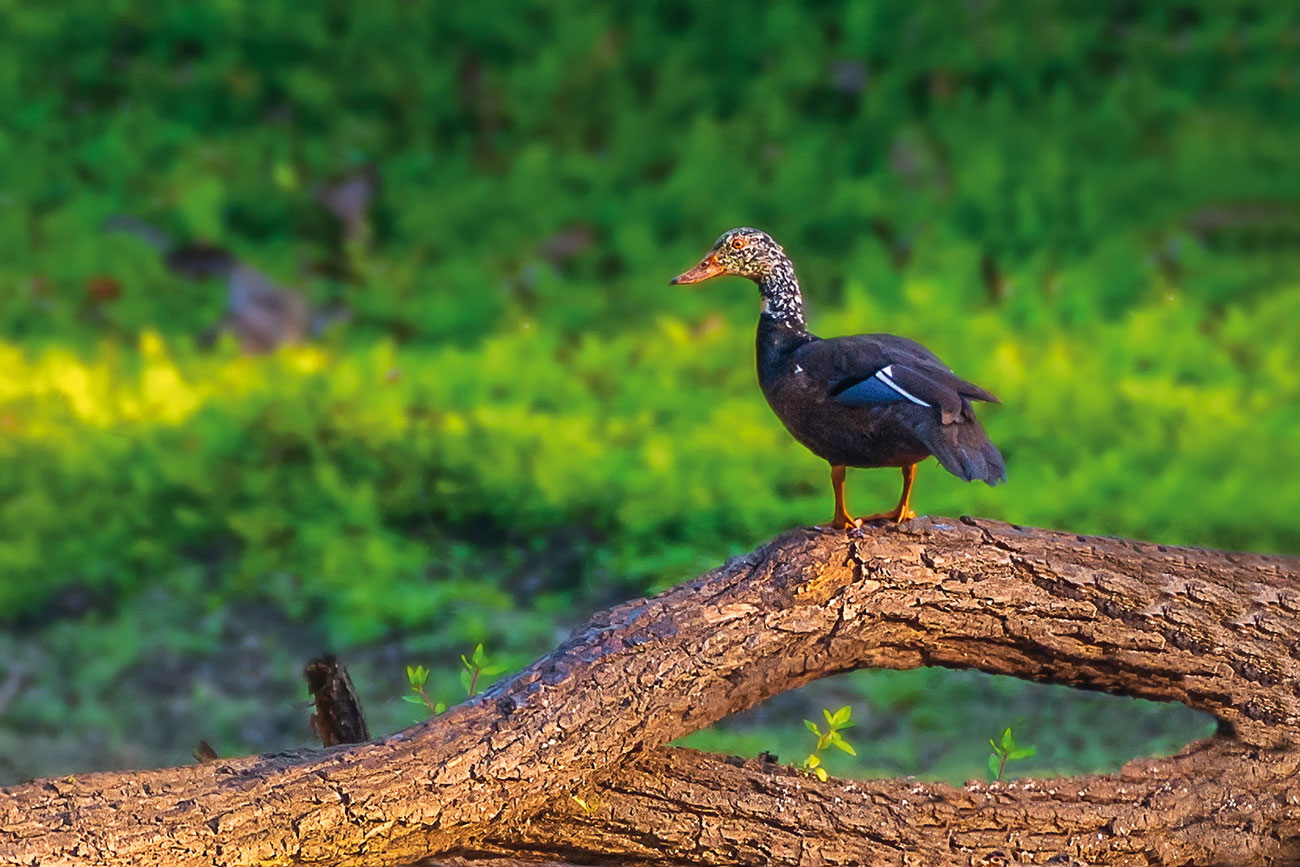
The author’s sighting of a White-winged Wood Duck perched on a fallen log led to its long term study and subsequently strengthened the case for the notification of the Dihing-Patkai National Park. Photo: Soham Das/Sanctuary Photolibrary.
A few months later, on February 27, 1993, Bhuram Gogoi, a local villager who later became my guide, and his friend were in the rainforest of the west block of the Upper Dihing Reserve Forest by the side of an oil rig, perhaps furtively collecting the trickles of oil seeping from it. When I reached the site with Nur Hussain, my constant companion in those years, Bhuram was perturbed by our sudden arrival, but did not leave. I took this as a positive sign, swiftly befriended him, and put him at ease by telling him that we were there only in search of a rare duck! At ease with my avian pursuit, he promised me an instant sighting. We had hardly walked 30 m. when we came upon a jungle pool, and there, a few more metres ahead, sat a White-winged Wood Duck perched nonchalantly on a fallen log. It was a vital discovery, all thanks to Bhuram and our chance friendship. I instantly named the pool the ‘WWW Duck Pool’. Back then, locals did not have a name for the area, but with an increase in tourist footfall, they began calling it ‘Ranga Pahar’ (red mountain) on account of its reddish soil. That year, exactly three whole decades ago, was the beginning of a long-term study on the rare and elusive duck, which strengthened the case for the notification of the Dihing-Patkai National Park, a biodiverse Protected Area that I had mooted for primate conservation in 1987. The study included field observations on the duck’s daily activities, ecology, behaviour including nesting, population estimation, and threats to its survival. All to lay the ground for the decision to protect it, and identify more potential Protected Areas. Subsequently, another pool was found some distance away near the magazine (where explosive materials were stored) of Oil India Limited, which I promptly christened the ‘OIL Magazine Pool’. In their local language, birding guides still refer to it as ‘Bom Goodam Pukhuri’. Today both these pools are, however, outside the national park boundary.
For nearly two years on a regular basis and subsequently every once in a while, I visited these sites and had the opportunity to observe the elusive state bird of Assam for hours at a stretch from a close range. After attending a Population & Habitat Viability Analysis (PHVA) workshop at Bandar Lampung in Sumatra, Indonesia in 1993, I discovered that such observations were unheard of in the early 1990s. My photographs and observations of Wood Ducks in their natural habitat pleasantly surprised many of the participants.
Wood Duck Strongholds
Clearly, this duck had its stronghold in India in the west and east blocks of the Upper Dihing Reserve Forest, with increased disturbance in its former stronghold, the Dibru-Saikhowa National Park. Fascinated by the bird, I observed during my travels that small numbers were also distributed across Tinsukia district in its remaining fragmented rainforest pockets.
Besides the Upper Dihing and Dum Duma Reserve Forests, I recorded the ducks in Dangori, Torani, Burhi-Dihing, Duarmara, Namphai, Kakojan, Dirak, Tinkopani, Tokouwani, Hahkhati, Kumsong and Mesaki Reserve Forests (Tinsukia district). Also, in the Joypur Reserve Forest (Dibrugarh district); and the Poba Reserve Forest (Dhemaji district). The Dulung and Ranga Reserve Forests (Lakhimpur district), where there were past records, had no report for several decades. Part of Upper Dihing (west block), Dirak and Joypur now forms the Dihing-Patkai National Park.
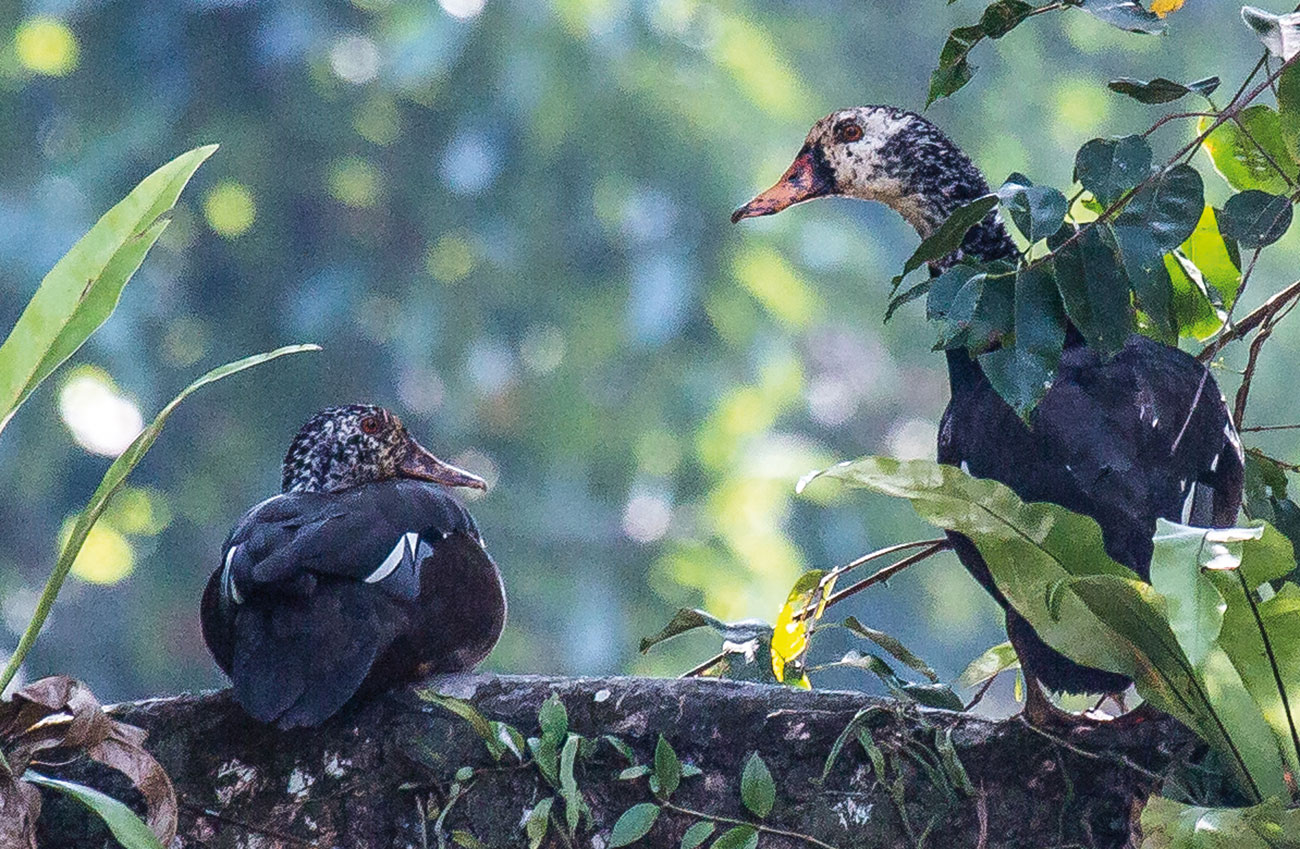
A pair of White-winged Wood Ducks in the Nameri National Park. This duck once had its stronghold in India in the west and east blocks of the Upper Dihing Reserve Forest. Nameri is another stronghold for the species. Photo: Roon Bhuyan/Sanctuary Photolibrary.
After Upper Dihing (including Dihing-Patkai), the next major stronghold is the Nameri National Park, with some populations in the Sonai-Rupai and Behali Wildlife Sanctuaries. Nameri is an outstanding area for the Wood Duck with my sighting success being best here. However, the most surprising find was in the Manas National Park, where I was lucky to watch the Wood Duck on two consecutive days in August 2006.
The Nambor complex of sanctuaries in Karbi Anglong and Golaghat districts, and the Hollongapar Gibbon Sanctuary also have a small number. There was an interesting record from Jatinga, a village in Dima Hasao district, which was noted during the ‘bird phenomenon’ night and narrated by late H.P. Phukan, who was then the Divisional Forest Officer at Haflong. There are no recent reports from the Barak valley region of southern Assam.
In Arunachal Pradesh, the Wood Duck was known from some reserved forests bordering Assam’s Tinsukia district and the Namdapha National Park. I received reports from the Manabhum and Tengapani Reserve Forests as well as the chaporis (riverine islands and tracts) of Dibang, Lohit and Siang (D’Ering Memorial Wildlife Sanctuary) rivers. The first reports from the Pakke Tiger Reserve and the Mehao Wildlife Sanctuary were published by me in Threatened Waterfowl Research Group Newsletter, U.K. in 1995. Pakke’s location, being contiguous with the Nameri National Park, has made it a high potential habitat for Wood Ducks. Now they also haunt the pools of Pakke river (Bordikorai in Assam) from Seijosa to upper areas.
There are no recent reports from Manipur, Meghalaya (once recorded in the Balpakram National Park), Mizoram, Nagaland (once recorded near Dimapur) and Tripura.
The White-winged Wood Duck was declared the focus species in two of Assam’s Protected Areas – the Dibru-Saikhowa and Dihing-Patkai National Parks. In my 1996 report (based upon studies in the early 1990s), Dibru-Saikhowa had an estimated 50 ducks while the Dihing-Patkai landscape had around 200 ducks. The table with figures from my report was also reproduced by BirdLife International in their classic publication Threatened Birds of Asia (in 2001). But during the intervening period, the situation has undergone drastic changes and by 2019-2020, the duck has lost nearly two-third of its population in the Dihing-Patkai landscape and the Dibru-Saikhowa population has plummeted by 90 per cent, and is alarmingly close to extirpation!
What’s in a name – White-winged Wood Duck or White-winged Duck?
The English common name White-winged Wood Duck was used universally in the late 19th Century and for much of the 20th Century. However, the intervention of Ben King et al. (1975), in their Field guide to the Birds of Southeast Asia, undertook rationalisation of English names, renamed this duck the slightly shorter White-winged Duck for brevity, presumably based on their third criterion for English names. The name White-winged Wood Duck has continued to be used widely in India and elsewhere in the range countries. In contrast, with a few exceptions, subsequent western authors have used the shortened form White-winged Duck. I always use the original English name, although some publications’ rigid application of editorial policy enforced the change. When a revised checklist for Indian birds was prepared (Praveen et al. 2016), I pleaded in favour of the original name and it was retained. I then pleaded globally through BirdingAsia of U.K., advocating its universal restoration. The main arguments in favour of White-winged Wood Duck were: 1. It is the original name, used for more than a century without any confusion or problem. 2. The species’ short popular name used in India, also very deep rooted, is ‘Wood Duck’. Villagers and Forest Department staff, who have some knowledge of birds, habitually refer to the species as ‘Wood Duck’; they are the key stakeholders in protection and overall conservation of this endangered species. In India, the name White-winged Duck has not become popular. 3. Today, Assam and Arunachal Pradesh comprise the global stronghold of the species, which has been recognised as Assam’s state bird – gazetted as White-winged Wood Duck in 2003, and in 1985 the original full name appeared on an Indian government Rs. 2 postage stamp.
There does remain an issue with American Wood Duck, now in most global lists simply named Wood Duck, which is avoidable. It is a generally applied principle of English names that no species should have a full name that is a subset of another species’ English name. India is crucial to its long-term conservation, and is the country with by far the largest number of people likely to refer to the species by an English name. There has been little use of the name White-winged Duck in India. Deferring globally to ongoing local use of White-winged Wood Duck seems important for the greater interest of the species’ conservation.
At least in my writings, both in BirdingAsia and Asian Journal of Ornithology (formerly Forktail), U.K., the full original name has been used, and also citing my article, the Australian Wood Duck’s case (a similar one to our Wood Duck’s) has been highlighted (and being used in Australia) by prominent ornithologist James A. Fitzsimons
The Life Of A Wood Duck
Although Wood Ducks are mostly sighted at dawn and dusk, I have observed several groups active during the day, taking short resting breaks in between. I once observed a group actively swimming and preening during daytime while another group roosted in a nearby tree. The ducks breed in tree holes (broken tree-tops are preferred), and the ducklings jump from the nest to the ground, which generally remains flooded. Hence, the breeding time of the species depends upon the wet season. The brood size maybe between two and 10, with an extreme range of one to 15. One to three eggs or ducklngs are unlikely, but can be observed owing to natural predation or opportunistic human collection.
I always felt that one male and two females represent the ‘ideal’ family size of the White-winged Wood Duck. Sightings of pairs are also common, but may possibly be the result of one duck having been killed. Post breeding, with sub-adults in the group, flock sizes might be as large as eight or nine. I once had the rare opportunity to spot the largest ever gathering of the species, 14 ducks, in Assam’s Dangori Reserve Forest in Tinsukia district on November 15, 1995. I surmised that some groups might have come together to roost after foraging in different parts of the forest. That was an unforgettable sight at Lohali, when I imagine several family groups and pairs must have flown in at the same time to roost in the safety of the trees. Wood Ducks are known for their honking calls and it is because of this call, generally heard in the villages at night during overhead flights, that it is locally called Deo Hanh (Spirit Duck) in Assamese.
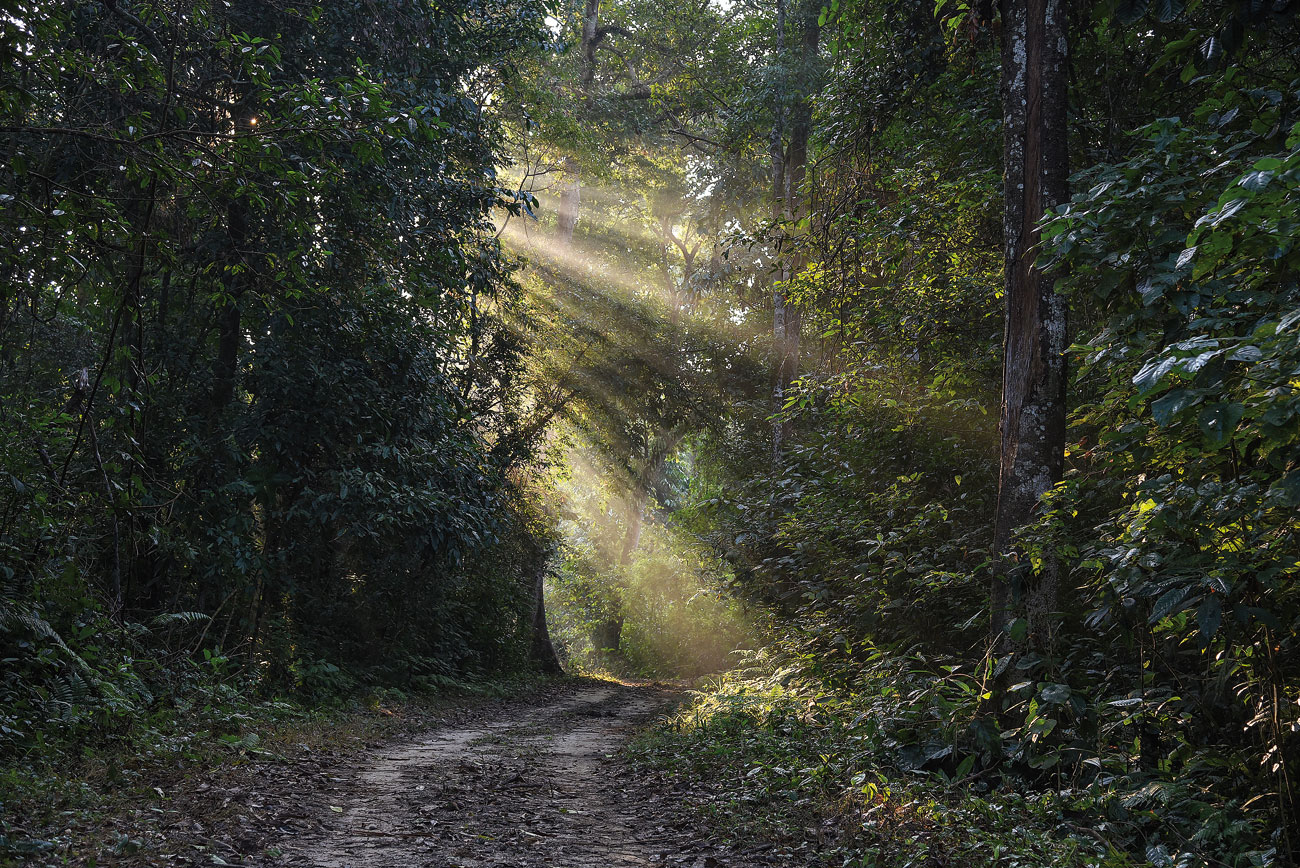
The Pakke Tiger Reserve landscape, typical of the White-winged Wood Duck’s habitat. The author published the first reports of the duck’s presence in Pakke, in 1995. Photo: Dr. Anish Andheria.
How Many Wood Ducks Are There?
Based on my studies in the early 1990s I estimated there were 291 Wood Ducks in eastern Assam’s Tinsukia and Dibrugarh districts, with about 59 in the eastern districts of Arunachal Pradesh. When I added Nameri and other surrounding areas, my total estimation was around 400. Although a repeat of my early 1990s study could not be done, I visited some of the key sites in 2000-2022 and concluded that the numbers had probably been reduced by one-third when compared to the 1990s. My old figures from the 90s are still in use across the globe, and a detailed revision is long overdue.
Wood Ducks need rainforests with intact tree cover and small waterbodies such as small jungle pools, or artificial water impoundments. They also prefer, slow-moving rivers and streams. Apart from habitat loss, opportunistic poaching, duckling collection and egg collection take a heavy toll on the species every year.
Being residents, they remain in one area around the year, leading to high natural predation of ducklings. Wood Ducks are good indicator species and my observations suggest that oil and coal mine pollution, the seasonal draining of jungle pools, fishing (including the use of deadly snares), and encroachment in prime habitats such as the Balipara, Naduar, Charduar and Bishnath Reserve Forests, also pose grave concerns. Without a doubt, tea plantations have also gulped large chunks of rainforests in upper Assam, replacing some of the finest Wood Duck habitats.
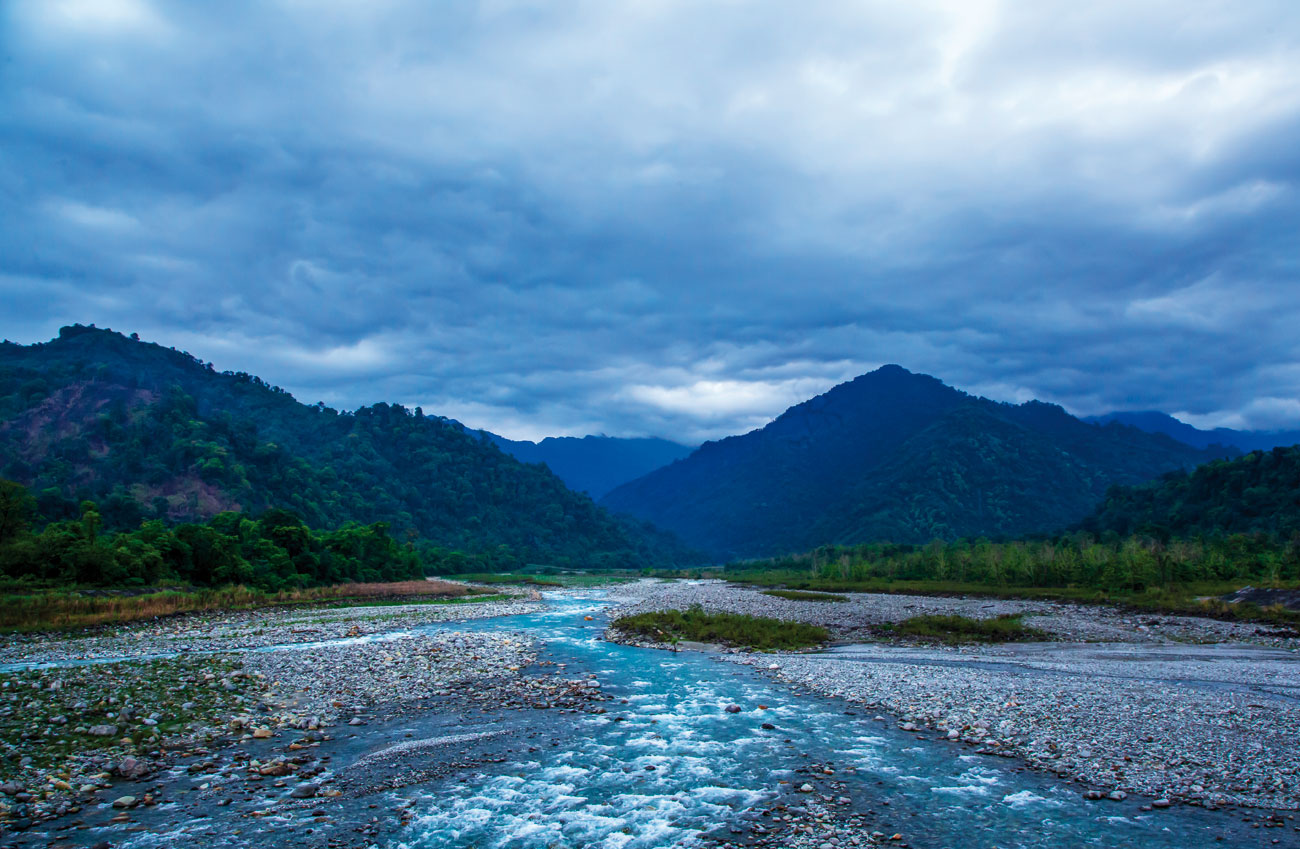
The Diffo river in Arunachal’s Dibang Valley. Wood ducks need rainforests with intact tree cover and small waterbodies. They also prefer, slow-moving rivers and streams. Photo: Samsul Huda Patgiri.
The State Bird
By the end of 2002, I had joined Assam’s Forest Department at the insistence of Pradyut Bordoloi, then Assam’s Forest Minister, and Principal Secretary L. Rynjah. Both Bordoloi, now a Lok Sabha MP, and the Principal Secretary tasked me with the job of nominating a State Bird (and other state wildlife icons) for Assam. While the Great Pied Hornbill was high on the list, there was no mention of the White-winged Wood Duck. I felt strongly that Assam’s State Bird should be the unique Wood Duck and both Minister and Principal Secretary L. Rynjah agreed. On March 31, 2003, it was declared so, together with its close associate the hollong tree Dipterocarpus macrocarpus, which became Assam’s State Tree.
The ‘bird phenomenon’ of Jatinga
The otherwise serene village of Jatinga, which is inhabited by the Jaintia tribals, annually witnesses a strange gathering of flocks upon flocks of birds of various species. These include bitterns, egrets, kingfishers, doves, pittas, drongos and many others. The birds are especially attracted to light – lamps and fire torches, on moonless nights with strong winds, when there is a dense fog or clouds in the months of August to October. As soon as the birds land on rooftops, trees or even the ground, villagers capture or kill them for meat. Individual catches used to be as high as 200, but have now gone down to about 60. Some birds crash into buildings and die; these accidents initially gave rise to the misconception that they come to the village to commit suicide! The village, nine kilometres southeast of the district headquarters Haflong of North Cachar Hills (now called Dima Hasao) in central Assam, has been marked as an Important Bird & Biodiversity Area (IBA) owing to this unique ornithological phenomenon, which requires special conservation efforts. In all likelihood the birds flock to the village lights for refuge, because when the weather clears up, they return to their roosts. As most of the birds flocking here are common and not protected by law, legal action to stop the killing lacks drive.
This box is based on text by the author from the BirdLife website http://datazone.birdlife.org/site/factsheet/jatinga-iba-india
Way Forward
I was privileged to lead the first ever systematic field study on the White-Winged Wood Duck in 1987-1988 and then again in 1992-1995. This resulted in several areas being declared as Protected Areas, including the Upper Dihing National Park (now called the Dihing-Patkai National Park) and the second was the Dum Duma-Dangori Wildlife Sanctuary (the proposal is still pending with the Assam Forest Department). Garampani and Nambor are also now protected and the Kobo-Poba area is likely to win government approval. In Arunachal Pradesh, one vital recommendation was a notification of the Dibang river as a national park, which is a lifeline for Wood Ducks as well as grassbirds. The matter has been discussed at the Arunachal Pradesh State Board for Wildlife meeting, but we still await positive news on this front. In this era of an advanced climate crisis, it is vital that protection measures in Dihing-Patkai and other equally fragile Protected Areas be strengthened.
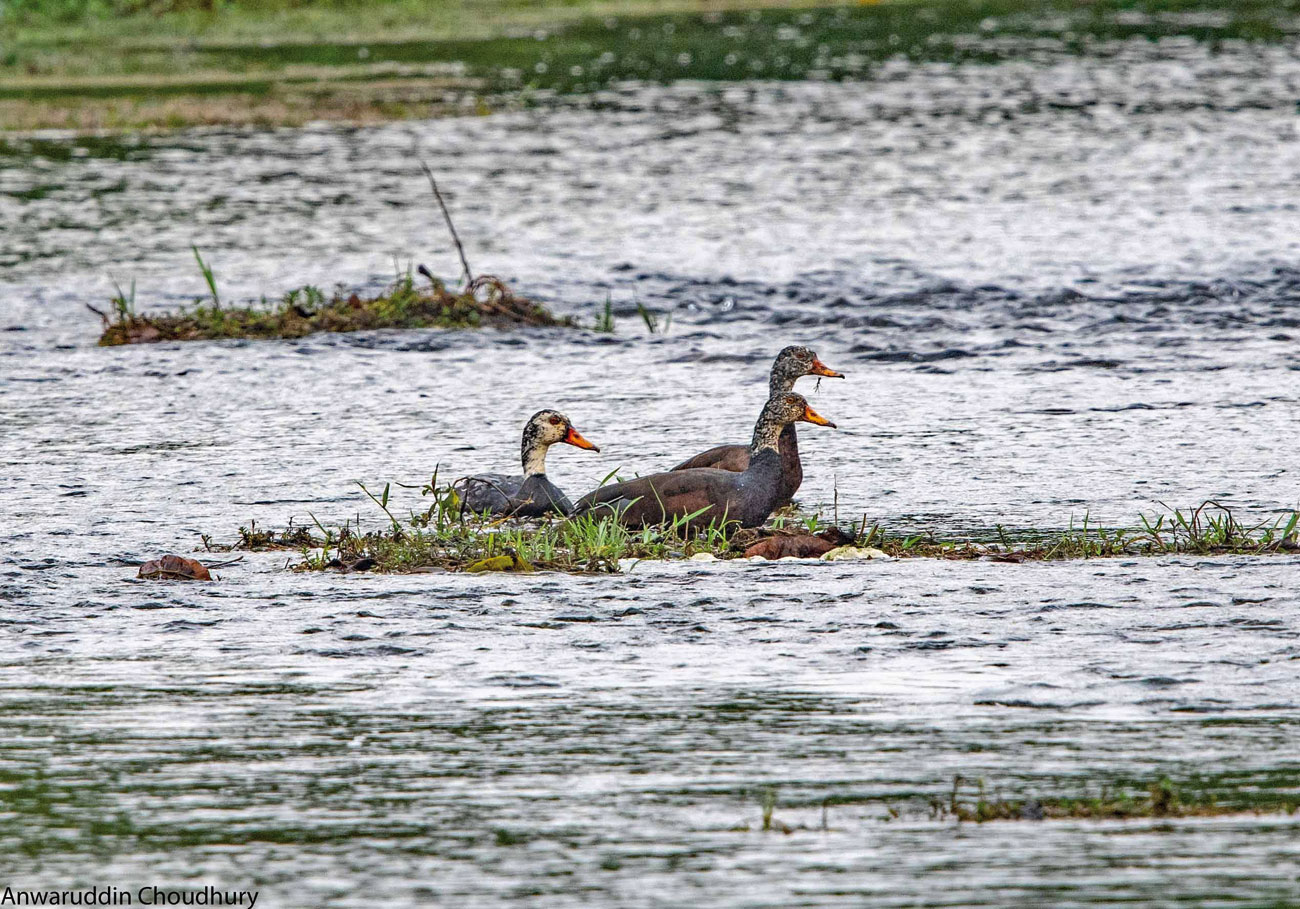
A rare sight of three White-Winged Wood Ducks in the Nameri National Park, photographed by the author. The author feels that one male and two females represent the ‘ideal’ family size of the White-winged Wood Duck. Dr. Anwaruddin Choudhury.
The removal of encroachers from the Nambor complex is a vital priority. At the very least the Kakojan, Tarani and Burhi-Dihing Reserve Forests should be upgraded to Conservation Reserves. Under the habitat management plan, some small jungle pools designed for the Wood Duck need to be created, and these would also serve as flood control infrastructure. Without delay, the Dihing-Patkai National Park needs to be enlarged to a minimum of 300 sq. km. to include the contiguous rainforests of the Upper Dihing (west block) Reserve Forest, and for Dum Duma-Dangori, hopefully the gazette notifications will be issued at the earliest possible time.
For me, the White-winged Wood Duck symbolises Northeast India as does the one-horned rhino. Its eponymous white patches, most noticeable in flight, black speckled head (though this can be completely white in Sumatran ducks), are synonymous with the forests and inland wetlands of the Northeast. The Wood Duck is one of the world’s most endangered avians with possibly only 250 to 999 (IUCN Red List) mature individuals left alive. We still have a chance to restore this species from its downward spiral toward extinction. The decisions we make today will decide its future, and possibly the future of the people of Assam too.
Dr. Anwaruddin Choudhury A retired civil servant, he is the author of 28 books, 51 reports and 950 articles. He has described three new species and one subspecies of mammals and has carried out a pioneering, detailed study of the White-winged Wood Duck.






